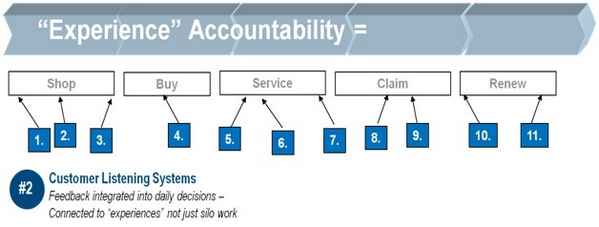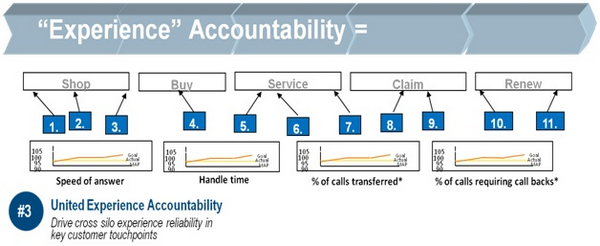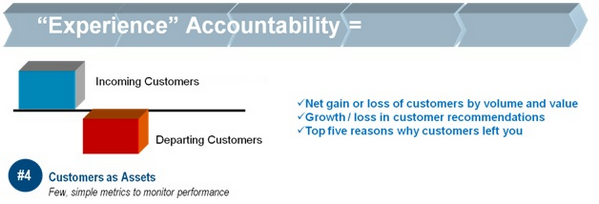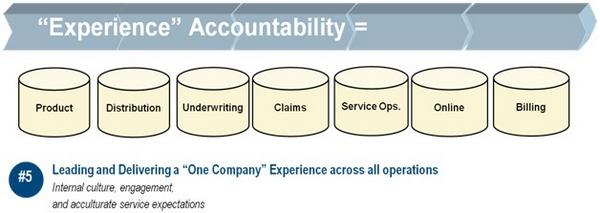This is a guest post from Jeanne Bliss — customer experience expert and author of “I Love You More Than My Dog.” See the original post this is adapted from and more like it on her blog.
To make customer experience stick as part of your operation, you need an organized and phased approach for integrating customer experience into your organization.
Based on working with scores of clients around the world, here is the REAL world approach. This framework will “demystify” the actions and the end state, which you should be able to recognize when your company and operation become proficient at customer experience.
These competencies don’t need to be tackled in order. Relevance to your operation is most important — getting traction is paramount.
Customer Experience Competency #1: Company-wide alignment around experience
Many organizations say they focus on their customer “experience,” but few do the hard work to define the stages of their experience from the customer journey point of view. In the absence of this, all of the operating areas do their own thing, driven by their internal tasks, agenda, and scorecard.
A lot of work is done, often in the name of the customer, but it doesn’t add up from the customers’ experience to deliver a unified experience. Customer experience reliability isn’t managed because each silo manages projects to their own annual priorities and scorecards. The big things don’t get systemically fixed. We miss the opportunity for the big “wow” moments.
Critical checkpoint: Define the stages of the experience and the moments of truth that comprise all of the experience touch points.
Customer Experience Competency #2: Experience-based listening and feedback
Determine your listening system: Collecting and organizing the information is important to prevent “one-off” fixes and to attach issues to the appropriate stage in the customer experience. You need to determine how you can connect all of these listening “pipes” to take advantage of the information that enables you to trend and track it. (This includes discussing the IT implications of “buying” vs. “building” a listening system.)
By having everyday listening feedback, we loosen our reliance on surveys. We can take real-time action and also gain focus on the things that really matter.
Customer Experience Competency #3: United (cross-silo) experience reliability and accountability
Reliability in your experience is proactively managing the key touch points with shared accountability across the silos. This approach emancipates your organization from the one-note dependency on survey results for driving change. Operational KPIs means not waiting for survey results — but knowing before the results come in where your operation delivered, and where it did not.
Take these steps to begin to manage experience reliability:
- Identify and establish key operational performance indicators (KPIs) for your top 10-15 customer experience touch points.
- Bring cross-functional teams together to take experiences from “broken” to “reliable” (and ultimately to a differentiating moment). Once you get this process down, you can move past the top 10-15 touch points. But start with just these few — otherwise the work will become too overwhelming.
- Establish a “Customer Room.”
Customer Experience Competency #4: Prove the ROI connection between experience and growth
Reconcile “customers in” with “customers out” to know how well you are managing customers as an asset of your company. Go to the post Managing Customers As Assets to get more specifics on what comprises a good starting set of Guerrilla Metrics and a worksheet to determine where you are now.
Critical Checkpoints: For many companies, since every silo frequently has varying definitions, putting together these simple articulations of incoming and outgoing customers requires:
- Alignment in definition (What is an incoming customer? What is an outgoing customer?)
- Alignment in data and databases
Customer Experience Competency #5: “One company” customer experience culture
To get started on your one company culture, I suggest four simple actions you can do now without spending much money. All it takes is passion, commitment, and making customer experience a priority.
- Call lost customers.
- Be a customer.
- Connect with the frontline.
- Do customer math.
Download: 4 Actions to Kick Start “One Company Culture”
Summary:
- Competency #1 – Define the stages of experience to gain alignment around customer experience
- Competency #2 – Develop experience-based customer listening and feedback
- Competency #3 – United (cross-silo) experience reliability and accountability
- Competency #4 – Manage customers as assets — prove the ROI between experience and growth
- Competency #5 – Create a “one company” customer experience culture
About Jeanne Bliss
As “Chief Customer Officer” for Lands’ End, Mazda, Coldwell Banker, Allstate, and Microsoft, Jeanne got “customer” on the strategic agenda, earned 98% loyalty rates, and changed experiences across 50,000-person operations. Jeanne now runs CustomerBliss to create an actionable path for profitability and business growth -- through earning customer and employee raves. Her best-selling books are Chief Customer Officer and I Love You More than My Dog: Five Decisions that Drive
- Web |
- More Posts(64)







